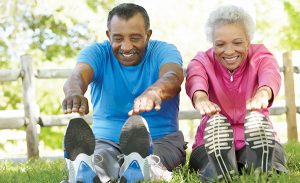Osteoarthritis Pain Relief: 4 Exercises
Osteoarthritis – and its aching joint pain – often keep people from doing one of the best things proven to make them feel better: exercise.
Studies show that staying physically active helps reduce osteoarthritis pain, improves function, and positively affects a person’s quality of life. Regular exercise also helps people sleep better, maintain a healthy body weight, and keep an upbeat attitude.
Roughly 27 million people over the age of 25 have osteoarthritis – a degenerative joint disease. Osteoarthritis mostly affects cartilage. The surface layer of cartilage breaks and wears away, allowing bones to rub together. Pain, swelling, and loss of motion of the joint result. Over time, the joint may lose its normal shape and small deposits of bone – bone spurs – may grow. Sometimes bits of bone or cartilage can break off and float inside the joint space.
Although osteoarthritis becomes more common with age, younger people can develop it, too. Osteoarthritis is also more likely to occur in people who are overweight or who are in jobs that stress particular joints.
Exercising also helps people with osteoarthritis manage other chronic conditions that are common among adults: diabetes, heart disease, and obesity.
Osteoarthritis Pain Relief
Four forms of exercise for people with osteoarthritis include:
Flexibility – Get flexible with Yoga and Tai Chi, exercises that help alleviate stiffness and keep the body’s joints moving.
Strengthening – Weightlifting and other weight-bearing exercises can help you keep and build your muscles. Small hand weights can help build upper and lower arm strength. Squats and lunges strengthen the lower body while planks work the entire core.
Aerobic and Endurance – Swimming and biking are both excellent forms of aerobic and endurance exercises, which can help reduce swelling in some joints. Endurance exercise is also good for the heart and arteries.
Balance and Agility – Ask your physical therapist which specific balance and agility exercises are right for you.
Always check with your physical therapist or physician before starting any exercise program. Some types of activity may need to be avoided, especially when joints are swollen or inflamed.
Source: National Institutes of Health, Centers for Disease Control and Prevention
Learn about exercise, nutrition counseling and diabetes management by visiting Bon Secours Physical Therapy www.bonsecoursphysicaltherapy.com

Comments are closed